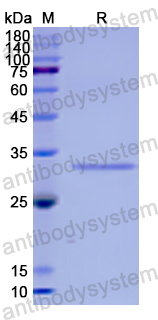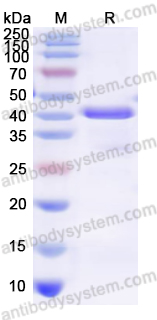Catalog No.
YHF00101
Expression system
E. coli
Species
Homo sapiens (Human)
Protein length
Met1-Ser268
Predicted molecular weight
32.91 kDa
Nature
Recombinant
Endotoxin level
Please contact with the lab for this information.
Purity
>90% as determined by SDS-PAGE.
Accession
P53701
Applications
ELISA, Immunogen, SDS-PAGE, WB, Bioactivity testing in progress
Form
Lyophilized
Storage buffer
Lyophilized from a solution in PBS pH 7.4, 0.02% NLS, 1mM EDTA, 4% Trehalose, 1% Mannitol.
Reconstitution
Reconstitute in sterile water for a stock solution. A copy of datasheet will be provided with the products, please refer to it for details.
Shipping
In general, proteins are provided as lyophilized powder/frozen liquid. They are shipped out with dry ice/blue ice unless customers require otherwise.
Stability and Storage
Use a manual defrost freezer and avoid repeated freeze thaw cycles. Store at 2 to 8°C for frequent use. Store at -20 to -80°C for twelve months from the date of receipt.
Alternative Names
CCHL, HCCS, Holocytochrome c-type synthase, Cytochrome c-type heme lyase
HCV-related hepatocellular carcinoma: gene signatures associated with TERT promoter mutations and sex., PMID:40495193
Histopathologic deep learning model for predicting tumor response to hepatic arterial infusion chemotherapy plus TKIs and ICIs in large hepatocellular carcinoma., PMID:40481560
Precision targeting of β-catenin induces tumor reprogramming and immunity in hepatocellular cancers., PMID:40442146
Transarterial chemoembolization combined with tyrosine kinase inhibitors and/or immune checkpoint inhibitors induced hypothyroidism is associated with improved overall survival in hepatocellular carcinoma., PMID:40411565
Semiquantitative analysis of 18F-aluminum fluoride fibroblast activation protein inhibitor 42 PET/computed tomography in primary liver cancer and factors influencing imaging positivity rates., PMID:40390512
HBV-driven host chromatin accessibility changes affect liver metabolic pathways, iron homeostasis and promote a preneoplastic phenotype., PMID:40380227
Unveiling the nexus of p53 and PD-L1: insights into immunotherapy resistance mechanisms in hepatocellular carcinoma., PMID:40371157
Performance of the GALAD Model in an Asian Cohort Undergoing Hepatocellular Carcinoma Surveillance: A Prospective Cohort Study., PMID:40346978
MiR-22/GLUT1 Axis Induces Metabolic Reprogramming and Sorafenib Resistance in Hepatocellular Carcinoma., PMID:40332478
Wogonin potentiates the irradiation effect on hepatocellular carcinoma by activating the Hippo-Yes-associated protein/transcriptional co-activator with PDZ-binding motif pathway., PMID:40318272
The DNA Methylation is Involved in Liver Cancer Metastasis via Regulation of E- cadherin Gene., PMID:40302090
High Fibroblast Activation Protein Expression in Hepatocellular Carcinoma: CT Imaging Features and Histological Characteristics., PMID:40254479
Geographic and Viral Etiology Patterns of TERT Promoter and CTNNB1 Exon 3 Mutations in Hepatocellular Carcinoma: A Comprehensive Review., PMID:40243493
ARL8B regulates lysosomal function and predicts poor prognosis in hepatocellular carcinoma., PMID:40210693
SEPT9 and PAI-1 are immunohistochemical biomarkers of the hepatocellular carcinoma immune microenvironment., PMID:40192891
A Huge Hepatocellular Carcinoma With Major Arteriovenous Shunt Successfully Treated With Chemoembolization Plus Lenvatinib Therapy Followed by Radiotherapy., PMID:40155018
ACVR2A attenuation impacts lactate production and hyperglycolytic conditions attracting regulatory T cells in hepatocellular carcinoma., PMID:40139191
Clinical characteristics and risk factors of hepatocellular carcinoma development in Budd-Chiari syndrome patients after endovascular treatment., PMID:40121156
Progress in ubiquitination and hepatocellular carcinoma: a bibliometric analysis., PMID:40117016
Multiomics in silico analysis identifies TM4SF4 as a cell surface target in hepatocellular carcinoma., PMID:39999090
Complete Response to Immunotherapy in Patients With Hepatocellular Carcinoma., PMID:39998829
Comprehensive Analysis of the Role of Heat Shock Proteins in the Immune Microenvironment and Clinical Significance of Hepatocellular Carcinoma., PMID:39991516
Nuclear localization of BRCA1-associated protein 1 is important in suppressing hepatocellular carcinoma metastasis via CTCF and NRF1/OGT axis., PMID:39984455
Radiological and clinical signatures to differentiate hepatocellular carcinoma from hepatoblastoma in children older than 5 years of age: a feasibility study., PMID:39961817
Inhibition of LGR5/β-Catenin Axis and Activation of miR134 Are Critically Involved in Apoptotic Effect of Sanggenol L in Hepatocellular Carcinoma., PMID:39956588
Clinical characteristics and treatment outcomes in multiple sclerosis patients treated with anti-CD20s who switched to fumarates: a retrospective analysis of a US healthcare claims database., PMID:39936542
The Cell Polarity Protein MPP5/PALS1 Controls the Subcellular Localization of the Oncogenes YAP and TAZ in Liver Cancer., PMID:39859373
Fatty Acid Synthase (FASN) Inhibitors Suppress Metformin-Induced Fat Accumulation and Apoptosis in H4IIE Hepatocellular Carcinoma Cells., PMID:39845516
FAM136A depletion induces mitochondrial stress and reduces mitochondrial membrane potential and ATP production., PMID:39821719
miRNA-541-5p regulates myocardial ischemia-reperfusion injury by targeting ferroptosis., PMID:39815273
ADARp110 promotes hepatocellular carcinoma progression via stabilization of CD24 mRNA., PMID:39808660
HBx Facilitates Drug Resistance in Hepatocellular Carcinoma via CD133-regulated Self-renewal of Liver Cancer Stem Cells., PMID:39801781
Membranous Overexpression of Fibronectin Predicts Microvascular Invasion and Poor Survival Outcomes in Patients with Hepatocellular Carcinoma., PMID:39778882
Structural Insights into Mechanisms Underlying Mitochondrial and Bacterial Cytochrome c Synthases., PMID:39766190
Liver-specific gene PGRMC1 blocks c-Myc-induced hepatocarcinogenesis through ER stress-independent PERK activation., PMID:39747098
FBP1 controls liver cancer evolution from senescent MASH hepatocytes., PMID:39743585
LHX3 promotes EMT in hepatoma cell through β-catenin/TCF4 pathway., PMID:39702693
Vessels encapsulating tumor clusters contribute to the intratumor heterogeneity of HCC on Gd-EOB-DTPA-enhanced MRI., PMID:39670871
Integrated molecular characterization of sarcomatoid hepatocellular carcinoma., PMID:39657751
Albumin-muscle density score predicts overall survival in patients with hepatocellular cancer undergoing treatment with transarterial chemoembolization., PMID:39614916
[Hepatocellular carcinoma: Histological and molecular classifications]., PMID:39572319
Oncogenic role of PMEPA1 and its association with immune exhaustion and TGF-β activation in HCC., PMID:39524206
Clinicopathological Characteristics of Neutrophil-Rich Hepatocellular Carcinoma: An Uncommon Subtype of Primary Liver Cancer., PMID:39533751
Insight into the mechanisms regulating liver cancer stem cells by hepatitis B virus X protein., PMID:39529119
Correlation between CTNNB1 mutation status and tumour phenotype in hepatitis B virus-related hepatocellular carcinoma., PMID:39526926
Biogenesis of Cytochromes c and c1 in the Electron Transport Chain of Malaria Parasites., PMID:39481007
Management Consensus Guidelines for Hepatocellular Carcinoma: 2023 Update on Surveillance, Diagnosis, Systemic Treatment, and Posttreatment Monitoring by the Taiwan Liver Cancer Association and the Gastroenterological Society of Taiwan., PMID:39435274
Spatial Dynamics of T- and B-Cell Responses Predicts Clinical Outcome of Resectable and Unresectable Hepatocellular Carcinoma., PMID:39417698
Oncofetal MCB1 Is a Functional Biomarker for HCC Personalized Therapy., PMID:39402741
Integrated ubiquitomics characterization of hepatocellular carcinomas., PMID:39348425


